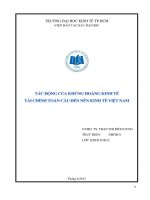Toàn cầu hóa và ảnh hưởng tới việt nam
Bạn đang xem bản rút gọn của tài liệu. Xem và tải ngay bản đầy đủ của tài liệu tại đây (353.56 KB, 4 trang )
perspective
e
n°3February2010
3
Local, global:
integrating mitigation
and adaptation
om
Fighting
climate change
Forests / Climate
Forestschange
/ Climate change
Bruno Locatelli
.c
S
on
g
th
an
co
ng
Since concerns about the present and potential impacts of climate change
first emerged, responses have focused more on reducing greenhouse gas
(GHG) emissions in the atmosphere, or “mitigation”, than on reducing the
vulnerability of societies and ecosystems to climate change, or “adaptation”. Today, climate change is seen as inevitable. Adaptation is therefore
becoming increasingly important in international and national policies,
as well as in local initiatives. Policies address mitigation and adaptation
separately, yet they are complementary and must both be implemented
at different levels, from the international to the local.
cu
u
du
Forests provide an interesting example of how this complementarity could
work. Ecosystem services are already recognised and remunerated in mitigation policies (reforestation and soon, perhaps, avoided deforestation).
But what about the role of forests in adaptation? How can mitigation and
adaptation be linked?
Global ecosystem services
persp ctive
e
In this publication
from the Cirad,
the researchers open
new lines of thought
and action based
on their research.
With their ability to capture and store
carbon, forests contribute to global
climate regulation and to climate change
mitigation. Reforestation makes it possible to increase carbon stocks in ecosystems. Reducing deforestation – which
represents between 15 and 20% of global
GHG emissions – is a way to conserve
existing stocks. While this ecosystembased climate mitigation cannot solve
the problem alone, it can complement
efforts made in other sectors such as
energy, industry, housing and transport.
CuuDuongThanCong.com
Carbon sequestration is recognised as
a global ecosystem service (see box on
next page). It is included in international
climate change agreements. For example,
the Kyoto Protocol Clean Development
Mechanism (CDM) remunerates the
contribution of afforestation and reforestation activities in tropical zones. As
regards avoided deforestation, or REDD
(Reducing Emissions from Deforestation
and Forest Degradation), negotiations are
underway to include it in the future international climate agreement.
/>
tric sector. In Indonesia, forests stabilise
hillsides and reduce landslides, which are
responsible for human and material losses
and which, according to certain studies,
could become more frequent in the future.
By breaking waves, mangroves and coastal
forests in Asia protect the populations
and their property during storms, a role
which could take on greater importance
with the potential increase in the force of
storms and sea level rise.
om
The services provided by forests therefore
contribute to reducing the vulnerability of populations and related economic
sectors – water, hydroelectricity, transport
– in the face of climate change and variability. However, they are not taken into
account in policies, whether international
or national, or in local adaptation projects,
which are mostly limited to a sectoral
approach.
.c
The authors of the Millennium Ecosystem
Assessment distinguish three types of services
provided by forests to humans:
• provisioning services – the production of
goods such as food, firewood, medicinal plants
and fibres;
• regulating services – the regulation of environmental processes such as the global climate
(through carbon sequestration), the quantity
and quality of water and the force of winds, etc.;
• cultural services, such as spiritual, cultural heritage or recreational benefits.
Ecosystem services are provided on several
spatial scales: immediate proximity (for landscape beauty, etc.), the watershed (for water
quality, etc.) and the world (for carbon sequestration, etc.). Regulation and cultural services
are termed “positive externalities” by economists, as they benefit human societies without
being taken into account by markets. These are
the services concerned by payments for environmental services (PES) (for water, landscape
beauty, etc.).
co
ng
Ecosystem
services
Local ecosystem services
on
du
u
The sustainable
management
of ecosystems
to help the society
to adapt
g
th
an
However, forests do not yet play a significant role in national and international adaptation policies. Indeed, they
may suffer from climate change, in which
case adaptation measures will be needed
for forest ecosystems, local populations
and forestry sectors. Furthermore, forests
provide ecosystem services that facilitate
adaptation to climate change in other
sectors of the economy and the society.
cu
They provide local populations with goods
that enable them to ensure or diversify
their livelihoods (provisioning services),
especially when harvests are poor.
They reduce exposure to climate events
(regulation services) by moderating the
force of winds and waves in coastal areas,
by fostering groundwater recharge, which
is useful during droughts, and by reducing air temperature – especially in cities
– during heatwaves, etc.
In Costa Rica, for example, the intensity
of rainfall has increased in recent years,
causing greater erosion and sedimentation
in hydroelectric dams. As forests protect
the ground, their conservation is seen as
an adaptation measure by the hydroelec-
CuuDuongThanCong.com
The Ecosystem-based Adaptation (EbA)
approach emerged recently in international talks on adaptation. In 2008 and
2009, countries like Brazil, Costa Rica,
Panama and Sri Lanka, along with nongovernmental organisations such as the
International Union for Conservation
of Nature, sent proposals to the Climate
Convention asking that EbA, defined
as the sustainable management of ecosystems to help the society to adapt, be
included in actions aimed at adaptation.
Certain proposals argue for recognition
of services provided by ecosystems, but
without suggesting any specific measures,
such as the remuneration of environmental services (see box on next page).
EbA could be more environmentally,
economically and socially effective and
sustainable than adaptation based exclusively on the creation of infrastructure,
for example investment in reservoirs and
dikes to cope with the impact of climate
change. EbA, which is particularly well
adapted to societies that are dependent on
natural resources, could also complement
other approaches in different contexts.
/>
Many PES schemes have been set up throughout the world. For example, since 1997, Costa
Rica has been paying landowners for four services (carbon sequestration, biodiversity, services
linked to hydrological services and landscape
beauty) provided by natural forests, forest plantations and agroforestry.
Certain conditions are required if PES is to be
effective: land regulations, social organisations
and institutional capacities. These make it possible to secure the provision of environmental
services, whether global (carbon payments) or
local (payments for hydrological services, for
example). Already implemented for climate
These elements, which are important for a better
governance of natural resources and the adaptation of societies, should not hide the fact that
PES is only one tool among others.
Adaptation and mitigation are not limited
to ecosystem services. They are part of
the broader issue of sustainable development (see box on the next page). They
presuppose that local populations have,
in the long term, diversified livelihoods
that enable them to avoid deforestation
and forest degradation. They also imply
creating networks to enable populations
and national or local institutions to share
knowledge and experience and to coordinate their practices. Finally, they require
flexibility to adapt to the rapid changes
and to the potential negative impacts of
measures taken. This means observing
and analysing the effects of measures,
making proposals for adjustments and
putting them into effect.
co
ng
Mitigation and adaptation:
conflict, synergy, integration
Moreover, PES may have positive effects on
institutions and local development. Certain
experiments have shown that they can incite
local communities to get involved in political
processes, contribute to improving the livelihoods of recipients, strengthen institutions and
create linkages between sectors, for example
those that manage ecosystems and those that
benefit from the services.
om
The beneficiaries of these services reward ecosystem managers for the services provided. PES
involves voluntary and contractual transactions
for one or several well-defined services.
mitigation, they could be used for adaptation
or even in synergy for both: a PES for carbon
sequestration may have a positive impact on the
conservation of other services, such as hydrological ones. And by remunerating the conservation of a forest to protect a watershed, a
local PES may contribute to conserving carbon
stocks.
.c
Payments for An innovative incentive mechanism to protect
environmental the environment, payments for environmental
services services (PES) emerged around 15 years ago.
du
cu
Klein R.J.T., Schipper E.L.F.
& Dessai S., 2005. Integrating
mitigation and adaptation into
climate and development policy:
Three research questions. Environmental Science & Policy,
8:579-588.
u
TO FIND OUT MORE
on
g
th
an
Ecosystem-based approaches can therefore be used for both mitigation and
adaptation. The interactions between
these two approaches may be positive or
negative. Conserving forests to mitigate
climate change at the global scale may
increase the production of local ecosystem services and facilitate adaptation in
local societies, just as an ecosystem-based
adaptation project will contribute to conserving forests and their carbon, and consequently to mitigating climate change.
Synergies are therefore possible. But mitigation measures may also be detrimental to the adaptation of local populations.
For example, to protect carbon stocks,
a REDD project may forbid or reduce
the local populations’ access to natural
resources, and thereby restrict possibilities
for development and adaptation.
Secretariat of the Convention on
Biological Diversity, 2009. Connecting Biodiversity and Climate
Change Mitigation and Adaptation: Report of the Second Ad
Hoc Technical Expert Group on
Biodiversity and Climate Change.
Montreal, Technical Series No.
41, 126 p.
Turner W.R., Oppenheimer M.
& Wilcove D.S., 2009. A force
to fight global warming. Nature,
462:278-279.
World Bank, 2008. Convenient
solutions for an inconvenient
truth: ecosystem based approaches
to climate change. Environment
Department, The World Bank,
Washington DC, 91 p.
Alone, the presence of ecosystems that
provide services is not enough. Vulnerable populations must also be able to
take advantage of them; they must have
rights and access to these resources. Safeguards are therefore necessary to ensure
mitigation projects do not harm local
populations.
CuuDuongThanCong.com
In order to reconcile global environmental
and local development issues, it is necessary to not only create linkages between
adaptation and mitigation measures, but
also to integrate both approaches into
policies concerning forestry, environment
and land-use planning. For example, development or nature conservation policies
would address the adaptation of local
populations and ecosystems to climate
change, and would also benefit from international funding for their contribution to
mitigation.
/>
tation processes. This implies defining
their rights, roles and responsibilities, for
example within exchange and negotiation platforms that must be created. This
involvement assumes that, in addition to
international and national policies, decisions can be made at the local level.
om
Useful for mitigation and adaptation, payments for environmental services (PES)
can be seen as one of many tools to foster
the integration of mitigation and adaptation. This conception implies acquiring
new knowledge: the role of ecosystem
services, implementation approaches
(remuneration, monitoring and assessment), regulatory frameworks and linkages with other tools, etc. Knowledge that
research is in the best position to produce.
.c
The distinction between sustainable development and adaptation to climate change is
unclear. Many of the measures proposed for
adaptation (such as capacity building or income
diversification) have long been implemented
as part of development projects. Furthermore,
before anticipating adaptation to future conditions, populations must first be able to respond
to current pressures (for example, climate variability or economic changes).
Between development activities (which deal
with current problems that are unrelated to
climate change) and adaptation activities
(which attempt to reduce future climate change
impacts), there exists a continuum. The more we
advance towards adaptation, the more it will be
necessary for policies to take into account the
future climate and the uncertainties linked to
the future, and to make it possible to test and
modify actions as changes occur. Failing this,
populations could become increasingly vulnerable.
Many scientists therefore argue for the systematic integration of adaptation into development
processes. Others see climate change as a possibility for making progress in terms of sustainable development, with the international
community’s increasing attention to the climate
making it possible to address many sustainable
development issues.
Scientists may also be mobilised as mediators between political decision-makers
and local stakeholders, facilitating the
transfer of information and taking part
in platforms for discussion between
researchers, politicians and citizens.
an
co
ng
Adaptation =
Development ?
on
Bruno Locatelli
u
A researcher in environmental
science at CIRAD, in the “Tropical
forest goods and ecosystem
services” research unit
( ),
he focuses on ecosystem services and
climate change. From 2002 to 2007
he worked in Central America on
climate mitigation and adaptation.
Since 2008, he has been working
with CIFOR (Center for
International Forestry Research)
in Indonesia, where he is responsible
for research on forests
and adaptation.
du
A few words about…
g
th
This kind of integration implies setting
up new forms of local, national and
international governance. For example,
it is essential to create linkages between
institutions and between sectors, between
those that manage ecosystems and those
that benefit from the services.
cu
As they are directly concerned, local
stakeholders are called upon to play a
major role in policy integration. To ensure
that policies are effective and equitable, their interests must be represented
during policy-making and implemen-
42, rue Scheffer
75116 Paris . FRANCE
www.cirad.fr
Developing policies and measures that
integrate adaptation and mitigation poses
certain challenges, both scientific and
political. Forests, along with agricultural,
agroforestry and silvopastoral systems,
are relevant to planning this integration
of the different uses of land and of the
ecosystem services provided from a multifunctional land use approach.
It is worth addressing these challenges
to ensure forestry and agricultural management benefit the global environment
and contribute to local development, in
today’s climate and that of the future.
This Perspective is the result of
the research studies conducted by
CIRAD as part of various projects in
partnership with the CATIE (Centro
Agronómico Tropical de Investigación y
Ensanza, Costa Rica) and CIFOR
(Centre for International Forestry
Research, Indonesia). This research
has given rise to several publications,
including:
entists? Mitigation and Adaptation of
Strategies for Global Change 14: 691696.
multi-criteria analysis. Forest Policy
and Economics 10(5): 275-285.
• Vignola R., Locatelli B., Martinez
C., Imbach P., 2009. Ecosystem-based
adaptation to climate change: what
role for policy-makers, society and sci-
• Locatelli B., Rojas V., Salinas Z.,
2008. Impacts of payments for environmental services on local development in northern Costa Rica: a fuzzy
The opinions expressed are those of the
author and do not necessarily reflect
those of the institution to which he
belongs.
CuuDuongThanCong.com
• Guariguata M., Cornelius J., Locatelli B., Forner C., Sánchez-Azofeifa
G.A., 2008. Mitigation needs adaptation: Tropical forestry and climate
change. Mitigation and Adaptation
Strategies for Global Change 13: 793808.
/>
• Locatelli B., Kanninen M., Brockhaus M., Colfer C.J.P., Murdiyarso
D. and Santoso H., 2008. Facing an
uncertain future: How forests and
people can adapt to climate change?
Forest Perspectives no. 5. CIFOR,
Bogor, Indonesia, 97 p.









